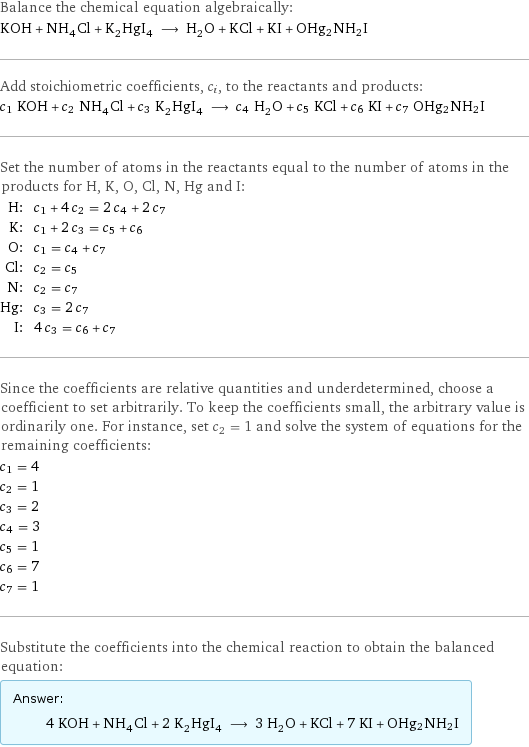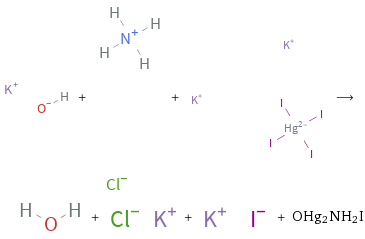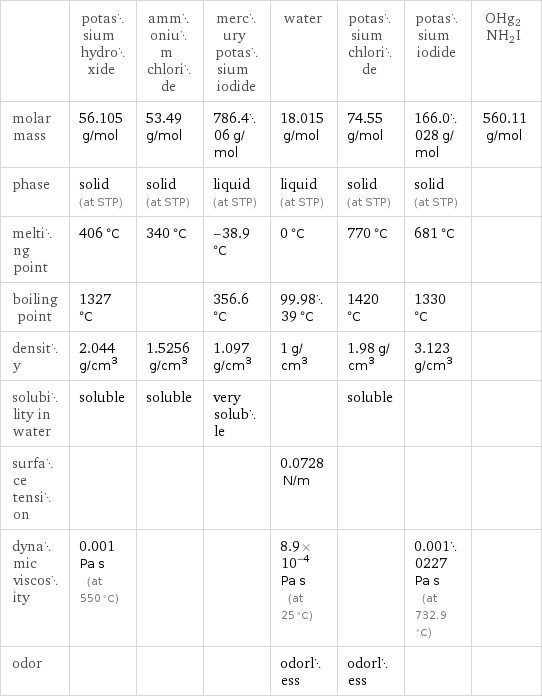Input interpretation

KOH potassium hydroxide + NH_4Cl ammonium chloride + K_2HgI_4 mercury potassium iodide ⟶ H_2O water + KCl potassium chloride + KI potassium iodide + OHg2NH2I
Balanced equation

Balance the chemical equation algebraically: KOH + NH_4Cl + K_2HgI_4 ⟶ H_2O + KCl + KI + OHg2NH2I Add stoichiometric coefficients, c_i, to the reactants and products: c_1 KOH + c_2 NH_4Cl + c_3 K_2HgI_4 ⟶ c_4 H_2O + c_5 KCl + c_6 KI + c_7 OHg2NH2I Set the number of atoms in the reactants equal to the number of atoms in the products for H, K, O, Cl, N, Hg and I: H: | c_1 + 4 c_2 = 2 c_4 + 2 c_7 K: | c_1 + 2 c_3 = c_5 + c_6 O: | c_1 = c_4 + c_7 Cl: | c_2 = c_5 N: | c_2 = c_7 Hg: | c_3 = 2 c_7 I: | 4 c_3 = c_6 + c_7 Since the coefficients are relative quantities and underdetermined, choose a coefficient to set arbitrarily. To keep the coefficients small, the arbitrary value is ordinarily one. For instance, set c_2 = 1 and solve the system of equations for the remaining coefficients: c_1 = 4 c_2 = 1 c_3 = 2 c_4 = 3 c_5 = 1 c_6 = 7 c_7 = 1 Substitute the coefficients into the chemical reaction to obtain the balanced equation: Answer: | | 4 KOH + NH_4Cl + 2 K_2HgI_4 ⟶ 3 H_2O + KCl + 7 KI + OHg2NH2I
Structures

+ + ⟶ + + + OHg2NH2I
Names

potassium hydroxide + ammonium chloride + mercury potassium iodide ⟶ water + potassium chloride + potassium iodide + OHg2NH2I
Equilibrium constant
![Construct the equilibrium constant, K, expression for: KOH + NH_4Cl + K_2HgI_4 ⟶ H_2O + KCl + KI + OHg2NH2I Plan: • Balance the chemical equation. • Determine the stoichiometric numbers. • Assemble the activity expression for each chemical species. • Use the activity expressions to build the equilibrium constant expression. Write the balanced chemical equation: 4 KOH + NH_4Cl + 2 K_2HgI_4 ⟶ 3 H_2O + KCl + 7 KI + OHg2NH2I Assign stoichiometric numbers, ν_i, using the stoichiometric coefficients, c_i, from the balanced chemical equation in the following manner: ν_i = -c_i for reactants and ν_i = c_i for products: chemical species | c_i | ν_i KOH | 4 | -4 NH_4Cl | 1 | -1 K_2HgI_4 | 2 | -2 H_2O | 3 | 3 KCl | 1 | 1 KI | 7 | 7 OHg2NH2I | 1 | 1 Assemble the activity expressions accounting for the state of matter and ν_i: chemical species | c_i | ν_i | activity expression KOH | 4 | -4 | ([KOH])^(-4) NH_4Cl | 1 | -1 | ([NH4Cl])^(-1) K_2HgI_4 | 2 | -2 | ([K2HgI4])^(-2) H_2O | 3 | 3 | ([H2O])^3 KCl | 1 | 1 | [KCl] KI | 7 | 7 | ([KI])^7 OHg2NH2I | 1 | 1 | [OHg2NH2I] The equilibrium constant symbol in the concentration basis is: K_c Mulitply the activity expressions to arrive at the K_c expression: Answer: | | K_c = ([KOH])^(-4) ([NH4Cl])^(-1) ([K2HgI4])^(-2) ([H2O])^3 [KCl] ([KI])^7 [OHg2NH2I] = (([H2O])^3 [KCl] ([KI])^7 [OHg2NH2I])/(([KOH])^4 [NH4Cl] ([K2HgI4])^2)](../image_source/e66de8f3f2d48fe4b127e28d0062fd2b.png)
Construct the equilibrium constant, K, expression for: KOH + NH_4Cl + K_2HgI_4 ⟶ H_2O + KCl + KI + OHg2NH2I Plan: • Balance the chemical equation. • Determine the stoichiometric numbers. • Assemble the activity expression for each chemical species. • Use the activity expressions to build the equilibrium constant expression. Write the balanced chemical equation: 4 KOH + NH_4Cl + 2 K_2HgI_4 ⟶ 3 H_2O + KCl + 7 KI + OHg2NH2I Assign stoichiometric numbers, ν_i, using the stoichiometric coefficients, c_i, from the balanced chemical equation in the following manner: ν_i = -c_i for reactants and ν_i = c_i for products: chemical species | c_i | ν_i KOH | 4 | -4 NH_4Cl | 1 | -1 K_2HgI_4 | 2 | -2 H_2O | 3 | 3 KCl | 1 | 1 KI | 7 | 7 OHg2NH2I | 1 | 1 Assemble the activity expressions accounting for the state of matter and ν_i: chemical species | c_i | ν_i | activity expression KOH | 4 | -4 | ([KOH])^(-4) NH_4Cl | 1 | -1 | ([NH4Cl])^(-1) K_2HgI_4 | 2 | -2 | ([K2HgI4])^(-2) H_2O | 3 | 3 | ([H2O])^3 KCl | 1 | 1 | [KCl] KI | 7 | 7 | ([KI])^7 OHg2NH2I | 1 | 1 | [OHg2NH2I] The equilibrium constant symbol in the concentration basis is: K_c Mulitply the activity expressions to arrive at the K_c expression: Answer: | | K_c = ([KOH])^(-4) ([NH4Cl])^(-1) ([K2HgI4])^(-2) ([H2O])^3 [KCl] ([KI])^7 [OHg2NH2I] = (([H2O])^3 [KCl] ([KI])^7 [OHg2NH2I])/(([KOH])^4 [NH4Cl] ([K2HgI4])^2)
Rate of reaction
![Construct the rate of reaction expression for: KOH + NH_4Cl + K_2HgI_4 ⟶ H_2O + KCl + KI + OHg2NH2I Plan: • Balance the chemical equation. • Determine the stoichiometric numbers. • Assemble the rate term for each chemical species. • Write the rate of reaction expression. Write the balanced chemical equation: 4 KOH + NH_4Cl + 2 K_2HgI_4 ⟶ 3 H_2O + KCl + 7 KI + OHg2NH2I Assign stoichiometric numbers, ν_i, using the stoichiometric coefficients, c_i, from the balanced chemical equation in the following manner: ν_i = -c_i for reactants and ν_i = c_i for products: chemical species | c_i | ν_i KOH | 4 | -4 NH_4Cl | 1 | -1 K_2HgI_4 | 2 | -2 H_2O | 3 | 3 KCl | 1 | 1 KI | 7 | 7 OHg2NH2I | 1 | 1 The rate term for each chemical species, B_i, is 1/ν_i(Δ[B_i])/(Δt) where [B_i] is the amount concentration and t is time: chemical species | c_i | ν_i | rate term KOH | 4 | -4 | -1/4 (Δ[KOH])/(Δt) NH_4Cl | 1 | -1 | -(Δ[NH4Cl])/(Δt) K_2HgI_4 | 2 | -2 | -1/2 (Δ[K2HgI4])/(Δt) H_2O | 3 | 3 | 1/3 (Δ[H2O])/(Δt) KCl | 1 | 1 | (Δ[KCl])/(Δt) KI | 7 | 7 | 1/7 (Δ[KI])/(Δt) OHg2NH2I | 1 | 1 | (Δ[OHg2NH2I])/(Δt) (for infinitesimal rate of change, replace Δ with d) Set the rate terms equal to each other to arrive at the rate expression: Answer: | | rate = -1/4 (Δ[KOH])/(Δt) = -(Δ[NH4Cl])/(Δt) = -1/2 (Δ[K2HgI4])/(Δt) = 1/3 (Δ[H2O])/(Δt) = (Δ[KCl])/(Δt) = 1/7 (Δ[KI])/(Δt) = (Δ[OHg2NH2I])/(Δt) (assuming constant volume and no accumulation of intermediates or side products)](../image_source/10fef487d0ee29b1a906c3d96fdbd93d.png)
Construct the rate of reaction expression for: KOH + NH_4Cl + K_2HgI_4 ⟶ H_2O + KCl + KI + OHg2NH2I Plan: • Balance the chemical equation. • Determine the stoichiometric numbers. • Assemble the rate term for each chemical species. • Write the rate of reaction expression. Write the balanced chemical equation: 4 KOH + NH_4Cl + 2 K_2HgI_4 ⟶ 3 H_2O + KCl + 7 KI + OHg2NH2I Assign stoichiometric numbers, ν_i, using the stoichiometric coefficients, c_i, from the balanced chemical equation in the following manner: ν_i = -c_i for reactants and ν_i = c_i for products: chemical species | c_i | ν_i KOH | 4 | -4 NH_4Cl | 1 | -1 K_2HgI_4 | 2 | -2 H_2O | 3 | 3 KCl | 1 | 1 KI | 7 | 7 OHg2NH2I | 1 | 1 The rate term for each chemical species, B_i, is 1/ν_i(Δ[B_i])/(Δt) where [B_i] is the amount concentration and t is time: chemical species | c_i | ν_i | rate term KOH | 4 | -4 | -1/4 (Δ[KOH])/(Δt) NH_4Cl | 1 | -1 | -(Δ[NH4Cl])/(Δt) K_2HgI_4 | 2 | -2 | -1/2 (Δ[K2HgI4])/(Δt) H_2O | 3 | 3 | 1/3 (Δ[H2O])/(Δt) KCl | 1 | 1 | (Δ[KCl])/(Δt) KI | 7 | 7 | 1/7 (Δ[KI])/(Δt) OHg2NH2I | 1 | 1 | (Δ[OHg2NH2I])/(Δt) (for infinitesimal rate of change, replace Δ with d) Set the rate terms equal to each other to arrive at the rate expression: Answer: | | rate = -1/4 (Δ[KOH])/(Δt) = -(Δ[NH4Cl])/(Δt) = -1/2 (Δ[K2HgI4])/(Δt) = 1/3 (Δ[H2O])/(Δt) = (Δ[KCl])/(Δt) = 1/7 (Δ[KI])/(Δt) = (Δ[OHg2NH2I])/(Δt) (assuming constant volume and no accumulation of intermediates or side products)
Chemical names and formulas

| potassium hydroxide | ammonium chloride | mercury potassium iodide | water | potassium chloride | potassium iodide | OHg2NH2I formula | KOH | NH_4Cl | K_2HgI_4 | H_2O | KCl | KI | OHg2NH2I Hill formula | HKO | ClH_4N | HgI_4K_2 | H_2O | ClK | IK | H2Hg2INO name | potassium hydroxide | ammonium chloride | mercury potassium iodide | water | potassium chloride | potassium iodide | IUPAC name | potassium hydroxide | ammonium chloride | dipotassium tetraiodomercury | water | potassium chloride | potassium iodide |
Substance properties

| potassium hydroxide | ammonium chloride | mercury potassium iodide | water | potassium chloride | potassium iodide | OHg2NH2I molar mass | 56.105 g/mol | 53.49 g/mol | 786.406 g/mol | 18.015 g/mol | 74.55 g/mol | 166.0028 g/mol | 560.11 g/mol phase | solid (at STP) | solid (at STP) | liquid (at STP) | liquid (at STP) | solid (at STP) | solid (at STP) | melting point | 406 °C | 340 °C | -38.9 °C | 0 °C | 770 °C | 681 °C | boiling point | 1327 °C | | 356.6 °C | 99.9839 °C | 1420 °C | 1330 °C | density | 2.044 g/cm^3 | 1.5256 g/cm^3 | 1.097 g/cm^3 | 1 g/cm^3 | 1.98 g/cm^3 | 3.123 g/cm^3 | solubility in water | soluble | soluble | very soluble | | soluble | | surface tension | | | | 0.0728 N/m | | | dynamic viscosity | 0.001 Pa s (at 550 °C) | | | 8.9×10^-4 Pa s (at 25 °C) | | 0.0010227 Pa s (at 732.9 °C) | odor | | | | odorless | odorless | |
Units
